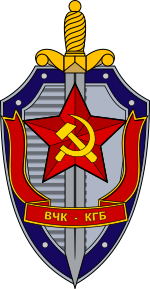
Back KGB Afrikaans لجنة أمن الدولة (الاتحاد السوفيتي) Arabic كيه جى بى ARZ KGB AST SSRİ Dövlət Təhlükəsizlik Komitəsi Azerbaijani СССР Дәүләт именлеге комитеты Bashkir Камітэт дзяржаўнай бяспекі СССР Byelorussian Камітэт дзяржаўнай бясьпекі СССР BE-X-OLD Комитет за държавна сигурност (СССР) Bulgarian কেজিবি Bengali/Bangla



KGB [1] is the Russian-language abbreviation for State Security Committee.[2] It was the main internal security agency for the Soviet Union from 1954 until its break-up in 1991. It was formed in 1954 as a successor of earlier agencies, the Cheka, NKVD, and MGB, after the deaths of Joseph Stalin and Lavrentiy Beria in 1953.
During the Cold War, the KGB suppressed "ideological subversion". This meant suppressing unorthodox political and religious ideas, and the people who held those ideas. It was Soviet policy for the KGB (and the secret services of the satellite states) to monitor public and private opinion, internal subversion and possible counter-revolutionary plots in the Soviet Bloc.
The KGB was instrumental in crushing the Hungarian Revolution of 1956, and the Prague Spring of "Socialism with a Human Face", in 1968 Czechoslovakia. A record of some of its doings is contained in the Mitrokin Archive.[3]
- ↑ transliteration of "КГБ"
- ↑ Russian:
 Комите́т госуда́рственной безопа́сности (help·info); Komitet gosudarstvennoy bezopasnosti
Комите́т госуда́рственной безопа́сности (help·info); Komitet gosudarstvennoy bezopasnosti
- ↑ Christopher Andrew. "The Sword and the Shield: The Mitrokhin Archive and the secret history of the KGB". The New York Times.